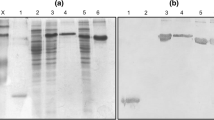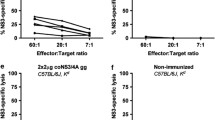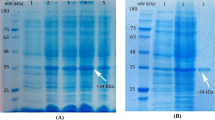Abstract
Development an effective vaccine may offer an alternative preventive and therapeutic strategy against HCV infection. DNA vaccination has been shown to induce robust humoral and cellular immunity and overcome many problems associated with conventional vaccines. In this study, mice were primed with either conventional pVRC-based or suicidal pSC-based DNA vaccines carrying DEC-205-targeted NS3 antigen (DEC-NS3) and boosted with type 5 adenoviral vectors encoding the partial NS3 and core antigens (C44P). The prime boost regimen induced a marked increase in antigen-specific humoral and T-cell responses in comparison with either rAd5-based vaccines or DEC-205-targeted DNA immunization in isolation. The protective effect against heterogeneous challenge was correlated with high levels of anti-NS3 IgG and T-cell-mediated immunity against NS3 peptides. Moreover, priming with a suicidal DNA vaccine (pSC-DEC-NS3), which elicited increased TNF-α-producing CD4+ and CD8+ T-cells against NS3-2 peptides (aa 1245–1461), after boosting, showed increased heterogeneous protective potential compared with priming with a conventional DNA vaccine (pVRC-DEC-NS3). In conclusion, a suicidal DNA vector (pSC-DEC-NS3) expressing DEC-205-targeted NS3 combined with boosting using an rAd5-based HCV vaccine (rAd5-C44P) is a good candidate for a safe and effective vaccine against HCV infection.





Similar content being viewed by others
References
Lavanchy D (2011) Evolving epidemiology of hepatitis C virus. Clin Microbiol Infect 17:107–115
Shi C, Ploss A (2013) Hepatitis C virus vaccines in the era of new direct-acting antivirals. Expert Rev Gastroenterol Hepatol 7:171–185
Lange CM, Zeuzem S (2013) Perspectives and challenges of interferon-free therapy for chronic hepatitis C. J Hepatol 58:583–592
Chatterji U, Garcia-Rivera JA, Baugh J, Gawlik K, Wong KA, Zhong W, Brass CA, Naoumov NV, Gallay PA (2014) The combination of alisporivir plus an NS5A inhibitor provides additive to synergistic anti-hepatitis C virus activity without detectable cross-resistance. Antimicrob Agents Chemother 58(6):3327–3334
Everson GT, Sims KD, Rodriguez-Torres M, Hézode C, Lawitz E, Bourlière M, Loustaud-Ratti V, Rustgi V, Schwartz H, Tatum H, Marcellin P, Pol S, Thuluvath PJ, Eley T, Wang X, Huang SP, McPhee F, Wind-Rotolo M, Chung E, Pasquinelli C, Grasela DM, Gardiner DF (2014) Efficacy of an interferon- and ribavirin-free regimen of daclatasvir, asunaprevir, and BMS-791325 in treatment-naive patients with HCV genotype 1 infection. Gastroenterology 146(2):420–429
Houghton M (2011) Prospects for prophylactic and therapeutic vaccines against the hepatitis C viruses. Immunol Rev 239:99–108
Neumann-Haefelin C, Thimme R (2013) Adaptive immune responses in hepatitis C virus infection. Curr Top Microbiol Immunol 369:243–262
Messina JP, Humphreys I, Flaxman A, Brown A, Cooke GS, Pybus OG, Barnes E (2014) Global distribution and prevalence of hepatitis C virus genotypes. Hepatology. doi:10.1002/hep.27259
Diepolder HM, Zachoval R, Hoffmann RM, Wierenga EA, Santantonio T, Jung MC, Eichenlaub D, Pape GR (1995) Possible mechanism involving T-lymphocyte response to non-structural protein 3 in viral clearance in acute hepatitis C virus infection. Lancet 346(8981):1006–1007
Habersetzer F, Baumert TF, Stoll-Keller F (2009) GI-5005, a yeast vector vaccine expressing an NS3-core fusion protein for chronic HCV infection. Curr Opin Mol Ther 11(4):456–462
Mikkelsen M, Holst PJ, Bukh J, Thomsen AR, Christensen JP (2011) Enhanced and sustained CD8+ T cell responses with an adenoviral vector-based hepatitis C virus vaccine encoding NS3 linked to the MHC class II chaperone protein invariant chain. J Immunol 186(4):2355–2364
Abdulhaqq SA, Weiner DB (2008) DNA vaccines: developing new strategies to enhance immune responses. Immunol Res 42(1–3):219–232
Barouch DH (2006) Rational design of gene-based vaccines. J Pathol 208:283–289
Hsu KF, Hung CF, Cheng WF, He L, Slater LA, Ling M, Wu TC (2001) Enhancement of suicidal DNA vaccine potency by linking Mycobacterium tuberculosis heat shock protein 70 to an antigen. Gene Ther 8(5):376–383
Kim TW, Hung CF, Juang J, He L, Hardwick JM, Wu TC (2004) Enhancement of suicidal DNA vaccine potency by delaying suicidal DNA-induced cell death. Gene Ther 11(3):336–342
Boscardin SB, Hafalla JCR, Masilamani RF, Kamphorst AO, Zebroski HA, Rai U, Morrot A, Zavala F, Steinman RM, Nussenzweig RS, Nussenzweig MC (2006) Antigen targeting to dendritic cells elicits long-lived T cell help for antibody responses. J Exp Med 203(3):599–606
Nchinda G, Kuroiwa J, Oks M, Trumpfheller C, Park CG, Huang Y, Hannaman D, Schlesinger SJ, Mizenina O, Nussenzweig MC, Uberla K, Steinman RM (2008) The efficacy of DNA vaccination is enhanced in mice by targeting the encoded protein to dendritic cells. J Clin Invest 118(4):1427–1436
Grossmann C, Tenbusch M, Nchinda G, Temchura V, Nabi G, Stone GW, Kornbluth RS, Uberla K (2009) Enhancement of the priming efficacy of DNA vaccines encoding dendritic cell-targeted antigens by synergistic toll-like receptor ligands. BMC Immunol 10:43
Yin X, Wang W, Tan WJ, Deng Y, Guan J, Wen B, Chen H, Ruan L (2011) Enhancement of the immune response in mice with a noval HCV DNA vaccine targeting NS3 to dendritic cells. Bing Du Xue Bao 27(1):44–49
Draper SJ, Heeney JL (2010) Viruses as vaccine vectors for infectious diseases and cancer. Nat Rev Microbial 8:62–73
Tatsis N, Ertl HC (2004) Adenoviruses as vaccine vectors. Mol Ther 10:616–629
Barnes E, Folgori A, Capone S, Swadling L, Aston S, Kurioka A, Meyer J, Huddart R, Smith K, Townsend R, Brown A, Antrobus R, Ammendola V, Naddeo M, O’Hara G, Willberg C, Harrison A, Grazioli F, Esposito ML, Siani L, Traboni C, Oo Y, Adams D, Hill A, Colloca S, Nicosia A, Cortese R, Klenerman P (2012) Novel adenovirus-basedvaccines induce broad and sustained T cell responses to HCV in man. Sci Transl Med 4:115ra111
Guan J, Wen B, Deng Y, Zhang K, Chen H, Wu X, Ruan L, Tan W (2011) Effect of route of delivery on heterologous protection against HCV induced by an adenovirus vector carrying HCV structural genes. Virol J 4(8):506
Guan J, Deng Y, Chen H, Yang Y, Wen B, Tan W (2014) Immunogenicity and heterologous protection in mice with a recombinant adenoviral-based vaccine carrying a hepatitis C virus truncated NS3 and core fusion protein. Bing Du Xue Bao (in press)
Colloca S, Barnes E, Folgori A, Ammendola V, Capone S, Cirillo A, Siani L, Naddeo M, Grazioli F, Esposito ML, Ambrosio M, Sparacino A, Bartiromo M, Meola A, Smith K, Kurioka A, O’Hara GA, Ewer KJ, Anagnostou N, Bliss C, Hill AV, Traboni C, Klenerman P, Cortese R, Nicosia A (2012) Vaccine vectors derived from a large collection of simian adenoviruses induce potent cellular immunity across multiple species. Sci Transl Med 4:115ra112
Folgori A et al (2006) A T-cell HCV vaccine eliciting effective immunity against heterologous virus challenge in chimpanzees. Nat Med 12:190–197
Matsui M, Moriya O, Akatsuka T (2003) Enhanced induction of hepatitis C virus-specific cytotoxic T lymphocytes and protective efficacy in mice by DNA vaccination followed by adenovirus boosting in combination with the interleukin-12 expression plasmid. Vaccine 21(15):1629–1639
Arribillaga L, de Cerio AL, Sarobe P, Sarobe P, Casares N, Gorriaiz M, Vales A, Bruna-Romero O, Borras-Cuesta F, Paranhos-Baccala G, Prieto J, Ruiz J, Lasarte JJ (2002) Vaccination with an adenoviral vector encoding hepatitis C virus (HCV) NS3 protein protects against infection with HCV-recombinant vaccinia virus. Vaccine 21(3–4):202–210
Murata K, Lechmann M, Qiao M, Gunji T, Alter HJ, Liang TJ (2003) Immunization with hepatitis C virus-like particles protects mice from recombinant hepatitis C virus-vaccinia infection. Proc Natl Acad Sci USA 100(11):6753–6758
Barouch DH, Yang ZY, Kong WP, Korioth-Schmitz B, Sumida SM, Truitt DM, Kishko MG, Arthur JC, Miura A, Mascola JR, Letvin NL, Nabel GJ (2005) A human T-cell leukemia virus type 1 regulatory element enhances the immunogenicity of human immunodeficiency virus type 1 DNA vaccines in mice and nonhuman primates. J Virol 79:8828–8834
Yin X, Lu J, Tan W (2010) Enhancement of the immune response of a novel DNA vaccine encoding conserved NS3 and Core fusion gene of HCV injected by intradermal electrotransfer in mice. Chin J Microbiol Immunol 30:41–45
Chen H, Wen B, Deng Y, Wang W, Yin X, Guan J, Ruan L, Tan W (2011) Enhanced effect of DNA immunization plus In Vivo electorporation with a combination of Hepatitis B Virus Core-PreS1 and S-PreS1 plasmids. Clin Vaccine Immunol 18:1789–1795
Verstrepen BE, Verschoor EJ, Fagrouch ZC, Mooij P, de Groot NG, Bontrop RE, Bogers WM, Heeney JL, Koopman G (2014) Strong vaccine-induced CD8 T-cell responses have cytolytic function in a chimpanzee clearing HCV infection. PLoS One 9(4):e95103
Ahlén G, Holmström F, Gibbs A, Alheim M, Frelin L (2014) Long-term functional duration of immune responses to HCV NS3/4A induced by DNA vaccination. Gene Ther. 21(8):739–750
Lang Kuhs KA, Ginsberg AA, Yan J, Wiseman RW, Khan AS, Sardesai NY, O’Connor DH, Weiner DB (2012) Hepatitis C virus NS3/NS4A DNA vaccine induces multiepitope T cell responses in rhesus macaques mimicking human immune responses [corrected]. Mol Ther 20(3):669–678
Ip PP, Boerma A, Regts J, Meijerhof T, Wilschut J, Nijman HW, Daemen T (2014) Alphavirus-based vaccines encoding nonstructural proteins of hepatitis C virus induce robust and protective T-cell responses. Mol Ther 22(4):881–890
Fournillier A, Frelin L, Jacquier E, Ahlén G, Brass A, Gerossier E, Holmström F, Broderick KE, Sardesai NY, Bonnefoy JY, Inchauspé G, Sällberg M (2013) A heterologous prime/boost vaccination strategy enhances the immunogenicity of therapeutic vaccines for hepatitis C virus. J Infect Dis 208(6):1008–1019
Acknowledgments
The authors thank Dr. Gary Nabel (VRC, NIH, USA) for providing the pVRC vector, Dr. Rod Bremner (University of Toronto, Canada) for providing the pSC vector and Dr. R.M. Steinman (The Rockefeller University, USA) for providing the DEC205 plasmid. This study was supported by the 863 Hi-Tech Research and Development Program of China (2007AA02Z455) and the National Natural Science Foundation of China (81373229).
Author information
Authors and Affiliations
Corresponding author
Additional information
J. Guan and Y. Deng are co-first authors.
Electronic supplementary material
Below is the link to the electronic supplementary material.
Rights and permissions
About this article
Cite this article
Guan, J., Deng, Y., Chen, H. et al. Priming with two DNA vaccines expressing hepatitis C virus NS3 protein targeting dendritic cells elicits superior heterologous protective potential in mice. Arch Virol 160, 2517–2524 (2015). https://doi.org/10.1007/s00705-015-2535-7
Received:
Accepted:
Published:
Issue Date:
DOI: https://doi.org/10.1007/s00705-015-2535-7




